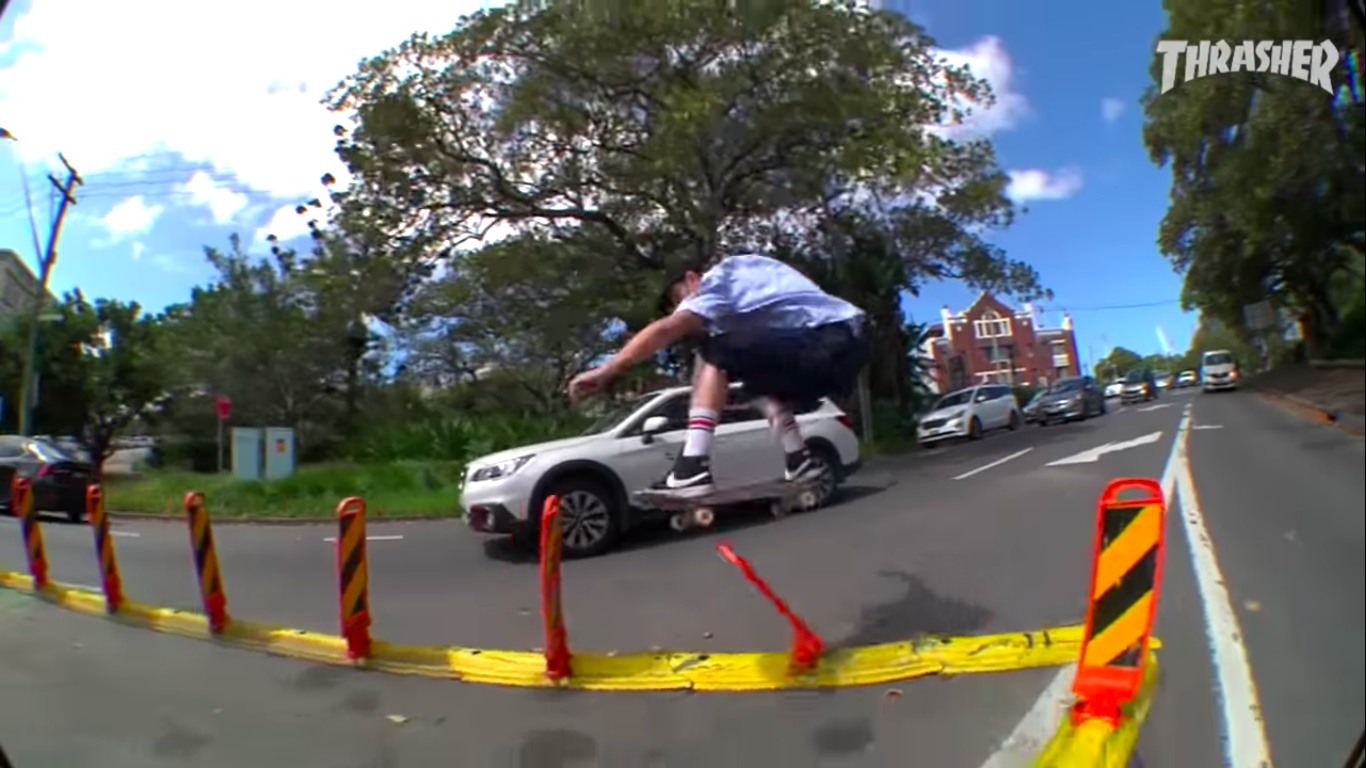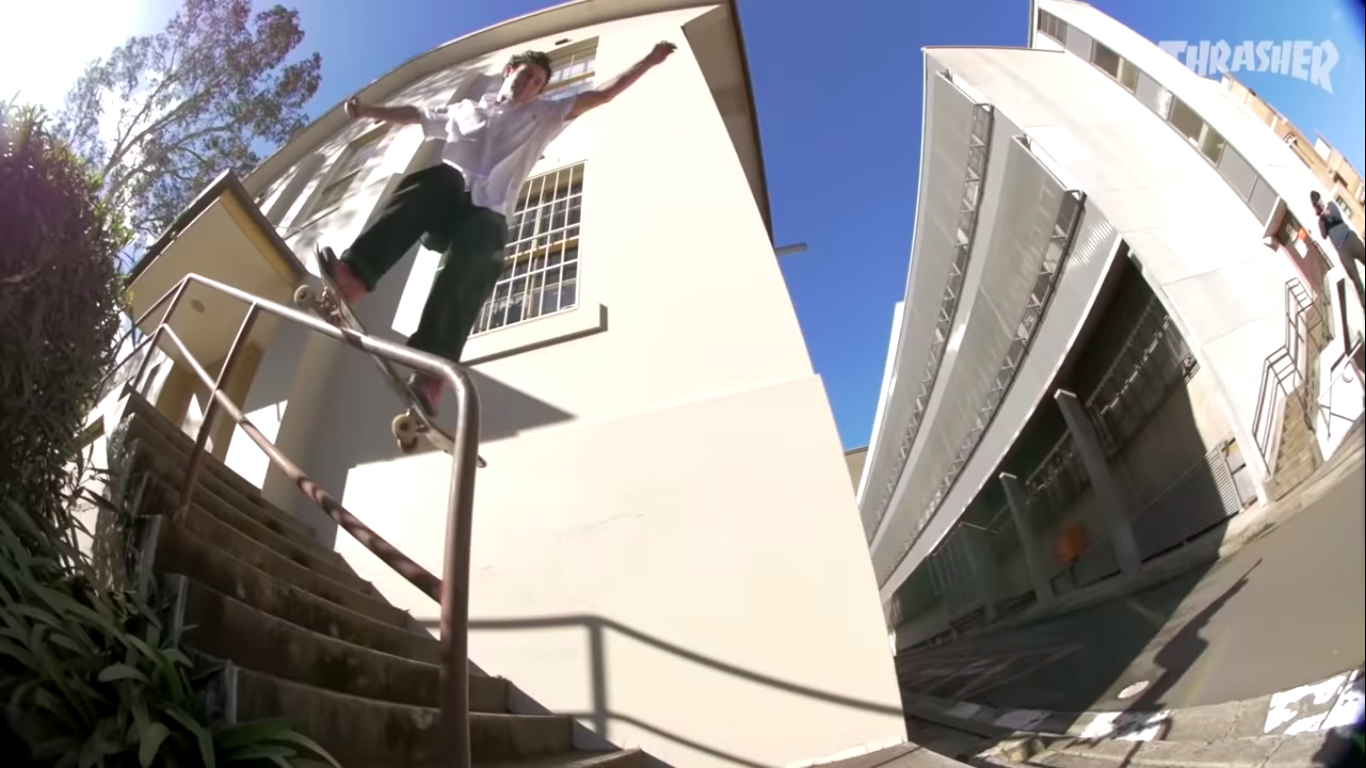Idiot Mode: Jack O'Grady's "Pass~Port" Part
Idiot mode is what it sounds like: the general ethos of an exceptionally reckless kind of skating. The state of mind when someone has dedicated themself to cheap thrills. When common sense is thrown out the door for pure menacing glee, doubt given way for titillation, hesitation for plunder, debate for single minded pursuit of self-destruction. It’s not skating a handrail, it’s nosediving down one that’s extra steep. It’s not simply throwing oneself down stairs, it’s plummeting from the top rope. It’s not just hucking, it’s careening toward the ground with the death drive of a crash test dummy. Here, slamming isn’t an accident, it’s a welcome outcome, if not the point. Idiot mode is exhibitionism, and the delight in making you flinch.
I got a good dose of idiot mode in Jack O’Grady’s pro-part for Pass Port on Thrasher. The kid is peril in the streets, electing to skate the steep, the long, the tall, and the generally ill-advised, all while going extremely fast. His is the type of skating that immediately captures your attention, and captures it for good reason: because of the immanence of danger, because of one person’s full-on dismissal of reason, because of an almost libidinous understanding of the city and architecture as the explosive fulfillment of ego. Rock and roll is often compared to this type of shredding—the beat, the religious demagogues once decried, the beat, the beat, the beat, it immitates sex. (As a teenager, I even asked my grandma why someone like Elvis seemed so controversial, and she, too, cited his rhythmic gyrations). In skating, it’s similar: it’s the party, it’s catharsis, it’s release. All that energy, all that momentum, all building up to the point at which the board leaves the ground, the body coming down with or without it.
I got a good dose of idiot mode in Jack O’Grady’s pro-part for Pass Port on Thrasher. The kid is peril in the streets, electing to skate the steep, the long, the tall, and the generally ill-advised, all while going extremely fast. His is the type of skating that immediately captures your attention, and captures it for good reason: because of the immanence of danger, because of one person’s full-on dismissal of reason, because of an almost libidinous understanding of the city and architecture as the explosive fulfillment of ego. Rock and roll is often compared to this type of shredding—the beat, the religious demagogues once decried, the beat, the beat, the beat, it immitates sex. (As a teenager, I even asked my grandma why someone like Elvis seemed so controversial, and she, too, cited his rhythmic gyrations). In skating, it’s similar: it’s the party, it’s catharsis, it’s release. All that energy, all that momentum, all building up to the point at which the board leaves the ground, the body coming down with or without it.
O’Grady has his own approach to idiot mode: his preternatural board control, and slam-dance-like commitment expressing themselves in the petty impulse to tap, slap, spank, bonk, and jostle everything with his board. In his opening line, he nose bonks some wonky plastic DOT stanchion, giving it a good whack the way some crooked cop in a movie wraps his billy club off a street post. Depraved, the trick is impossible to take your eyes off of, because we know someone is going to get it, even if, or, rather, because the gesture is just about O’Grady getting his kicks. His second line, too, partakes of this same engrossing cruelty: a gap to back noseblunt on a pair of benches is smooth in the way he glides from one into a two-wheeled slide on the other, but it is all a ruse. The tenderness and finesse is merely a set up for the room-silencing whap of a wally off a trash can, which he wantonly carries into the street, indulging its full follow through, as though he had just slapped us back to our senses.
What makes O’Grady’s skating true idiot mode is that it scales up infinitely. Yes, its nuances are best appreciated at ground level: careening off sidewalk fixtures like a dog in heat, leaving his stink everywhere. But the fact that the kid can bring the same energy—and, counterintuitively, finesse—to big stunts elevates him to the status of idiot king, effectively turning his sidewalk-style hijinks into full scale theater, and translating the infrastructural tap dance into a penchant for the narrow, the steep, the repetitive, the attenuated, and the just-barely. Handrails generally don’t seem to be enough: he has to gap out to them, gap off of them, or pop out of them, as we see multiple times in various scenarios. He gaps to lipslide a 5 flat 5 with the nihilism of Heath Kirchart; he gaps to noseblunt down a rough hewn concrete hubba, landing so precariously, it looks like his extra wide board is as slender (and wobbly) as a tightrope suspended over a deep chasm; and like a veritable monkey, he dips himself into a front smith before vaulting over a bit of sidewalk and curb, an about face of momentum that makes a fool of whoever proclaimed inertia an inviolable law of physics. Tying these clips, and their surly acrobatics, together is his ender, a miraculous ollie from one rail to another. When he lands on the second one, he sits on it like he owns the place.
The point is, these are clips you don’t just behold with your eyes (or, which force you to close them, should the situation get too harry). You feel this type of footage in your loins, a gut reaction. That’s definitely how I feel from the innumerable downhill clips, in which his takeoff point or landing lends extra levels of treacherousness and hostility to an already breakneck amount of risk—I mean, the one with the moss-covered ground. This same boundaries-pushing harrying, however, can also extend into discomforting territory. It’s disturbing to watch O’Grady end a line by pump-faking a heelflip at a motorist. Sure, the driver’s in their vehicle, but who wants to be flexed on by some gym-socks-wearing bloke? Who wants to be a bystander to this entitlement, this aggressiveness? It’s enough to make you feel vindicated when, after a bit of b&e, O’Grady ollies over some homeowner’s house gate, only to get served on impact with the street.
The point is, these are clips you don’t just behold with your eyes (or, which force you to close them, should the situation get too harry). You feel this type of footage in your loins, a gut reaction. That’s definitely how I feel from the innumerable downhill clips, in which his takeoff point or landing lends extra levels of treacherousness and hostility to an already breakneck amount of risk—I mean, the one with the moss-covered ground. This same boundaries-pushing harrying, however, can also extend into discomforting territory. It’s disturbing to watch O’Grady end a line by pump-faking a heelflip at a motorist. Sure, the driver’s in their vehicle, but who wants to be flexed on by some gym-socks-wearing bloke? Who wants to be a bystander to this entitlement, this aggressiveness? It’s enough to make you feel vindicated when, after a bit of b&e, O’Grady ollies over some homeowner’s house gate, only to get served on impact with the street.
Senselessness, however, is small sacrifice for the way O’Grady’s skating injects liveliness and excitement into the city that surrounds him—the way he keeps you on your toes. It is an affirmation that the city is still an interesting context, his mischief proof that they aren’t entirely sanitized. While O’Grady’s version of idiot mode comes off as PG when compared to forebears like Dustin Dollin, who laid bare the cravennes at the heart of this skating, and though one senses everywhere the subtle censors of O’Grady’s shoe sponsor, Nike, we nonetheless get treated to a healthy level of sketchiness—a sense that the reptilian underbelly of libido is coming out for some overdue sun, and cares little for the stir it causes by being out in public. Basically, that O’Grady’s skating is out there for everyone to see—and to be frightened by. It is perhaps for this reason that, when I think of O’Grady now, I picture a crooked smile smeared across his face. The expression is everywhere in his part, less a mood and more a scar left by a good punch in the mouth. I see it toward the end his part, when he kickflips from a parking lot into a steep, concrete bank, putting a hand down, as he steers out of a powerslide. All his friends erupt in surprise—surely they thought he was getting tossed. But with such a shit landing—or, sort of shit, anyway—O’Grady gets both the trick and the reaction that he wanted. Pleased with himself, he sticks out his tongue, and skates away. •••



